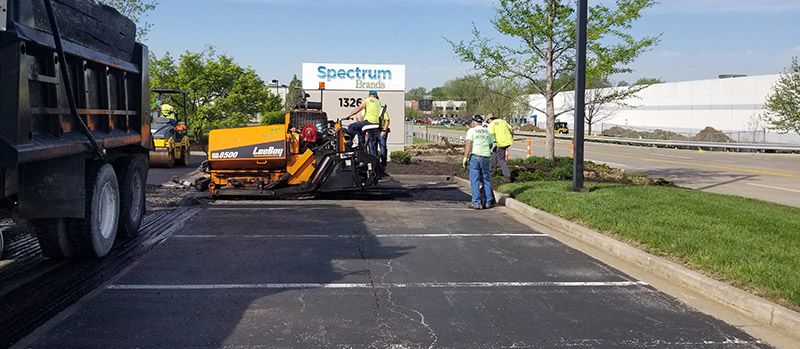The 6-Minute Rule for A1 Professional Asphalt & Sealing Llc
The 6-Minute Rule for A1 Professional Asphalt & Sealing Llc
Blog Article
Examine This Report about A1 Professional Asphalt & Sealing Llc
Table of ContentsThe smart Trick of A1 Professional Asphalt & Sealing Llc That Nobody is Talking AboutSome Of A1 Professional Asphalt & Sealing LlcThe Only Guide to A1 Professional Asphalt & Sealing LlcFascination About A1 Professional Asphalt & Sealing LlcThe Buzz on A1 Professional Asphalt & Sealing Llc

The oil in a car engine is not simply oil. It includes a variety of ingredients to enhance the vehicle's efficiency. These include polymers, thickness modifiers, heat stabilizers, added lubes, and wear ingredients. The REOB includes all the ingredients that were in the waste oil along with the wear metals from the engine (mainly iron and copper).
Nevertheless, by making several blends using various REOB samples and various asphalt binders, the variants largely can be averaged out. Numerous States provided examples of recognized REOB composition to TFHRC researchers, that evaluated the samples to compare the portion of included (recognized) REOB to the discovered (examined) quantity. The analyses revealed a comparable percentage of added and found REOB.
The Ultimate Guide To A1 Professional Asphalt & Sealing Llc
None of those States understood that the asphalt they were getting included REOB. One State urged its samples had no REOB - https://www.intensedebate.com/people/a1asphaltseal.
Of the 1,532 samples checked, 12 percent had REOB, and some contained appreciably high degrees of it at 1020 percent. The highest degree was 34 percent in a sample from Texas, which TxDOT had actually utilized in a patching compound. This screening likewise revealed the visibility of phosphoric acid in 11 percent of the examples, and 2 percent contained ground tire rubber.
2 years back at TRB's annual conference, the Federal scientists held an REOB workshop and presented the searchings for of their laboratory evaluations to a standing room-only group. Some companies do not specifically prohibit REOB, they do impose physical tests that avert its useeffectively a ban. Others do not outlaw it by specification, yet have contracts with asphalt distributors to prevent using REOB
About A1 Professional Asphalt & Sealing Llc
Ohio and Texas limit levels to much less than 5 percent of the asphalt. To create a dependable test method that all States can use, the TFHRC scientists established up a round-robin examination plan.
The participants are testing the examples separately using the standards supplied by the TFHRC researchers. The result will certainly be a suggested AASHTO examination technique that any State can embrace and utilize.
The pavement with REOB, which lies 0.6 mile (1 kilometer) from the pavement without REOB, has the same subgrade, web traffic thickness, and environment. The section of Highway655 with 5 to 10 percent REOB revealed considerable cracking. In this example, the visibility of REOB was the determined source of breaking at a reduced temperature levels.
A section of examination sidewalk in Minnesota (MN1-4) located to include REOB additionally cracked prematurely. The pavement carried out well for the very first 3 to 4 years, yet after that started to break.
How A1 Professional Asphalt & Sealing Llc can Save You Time, Stress, and Money.
The examinations were not considerable, yet they revealed that at degrees of 6 percent or more, the tensile strength of the asphalt dropped considerably. At a level of 3.5 percent REOB, the variation i thought about this in the physical examination approaches was higher than the impact of REOB. It was tough for researchers to evaluate whether REOB was existing. http://tupalo.com/en/users/6576607.

One binder parameter considered is the distinction between the low temperature level essential requirements temperature for rigidity (S) in the flexing beam rheometer and the flexing beam of light rheometer creep slope (m-value) kept in mind as Tcritical. Two independent research teams, one from AASHTO and the various other from the Asphalt Institute, concluded that even more research study is required on the use of REOB in asphalt.
Formerly, all asphalt testing measured design homes such as stiffness. These examinations do disappoint what products had actually been included in the asphalt. One example gotten throughout the TFHRC study had a really unusual evaluation. The sample had the adhering to test outcomes: Superpave PG 64-28 with a high temperature grade of 67.3 Tcritical on the flexing beam rheometer was 6.7 levels Celsius.

The Buzz on A1 Professional Asphalt & Sealing Llc
These outcomes show there are weaknesses in the standardized design screening protocols that may be made use of. The producer might have a financial benefit and the product passes all the standard examinations, but the item might not be valuable to making certain long-lasting performance. To resolve this problem and the growth of new asphalt ingredients and extenders, TFHRC is starting a study program to make use of handheld spectroscopic devices, x-ray fluorescence spectroscopy, and Fourier change infrared spectroscopy to allow analyses to be performed in the field instead than having to take examples back to the laboratory.
Report this page